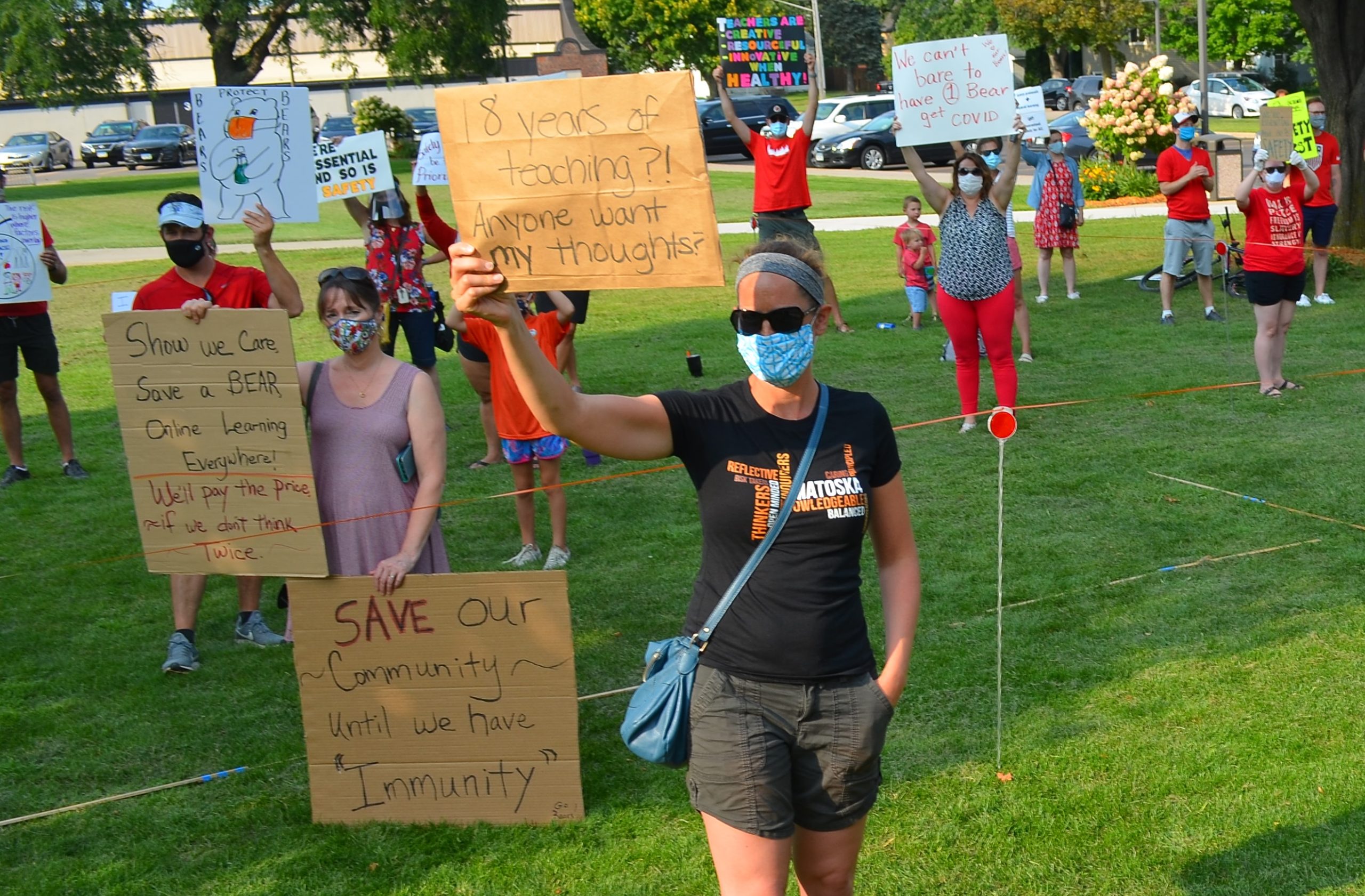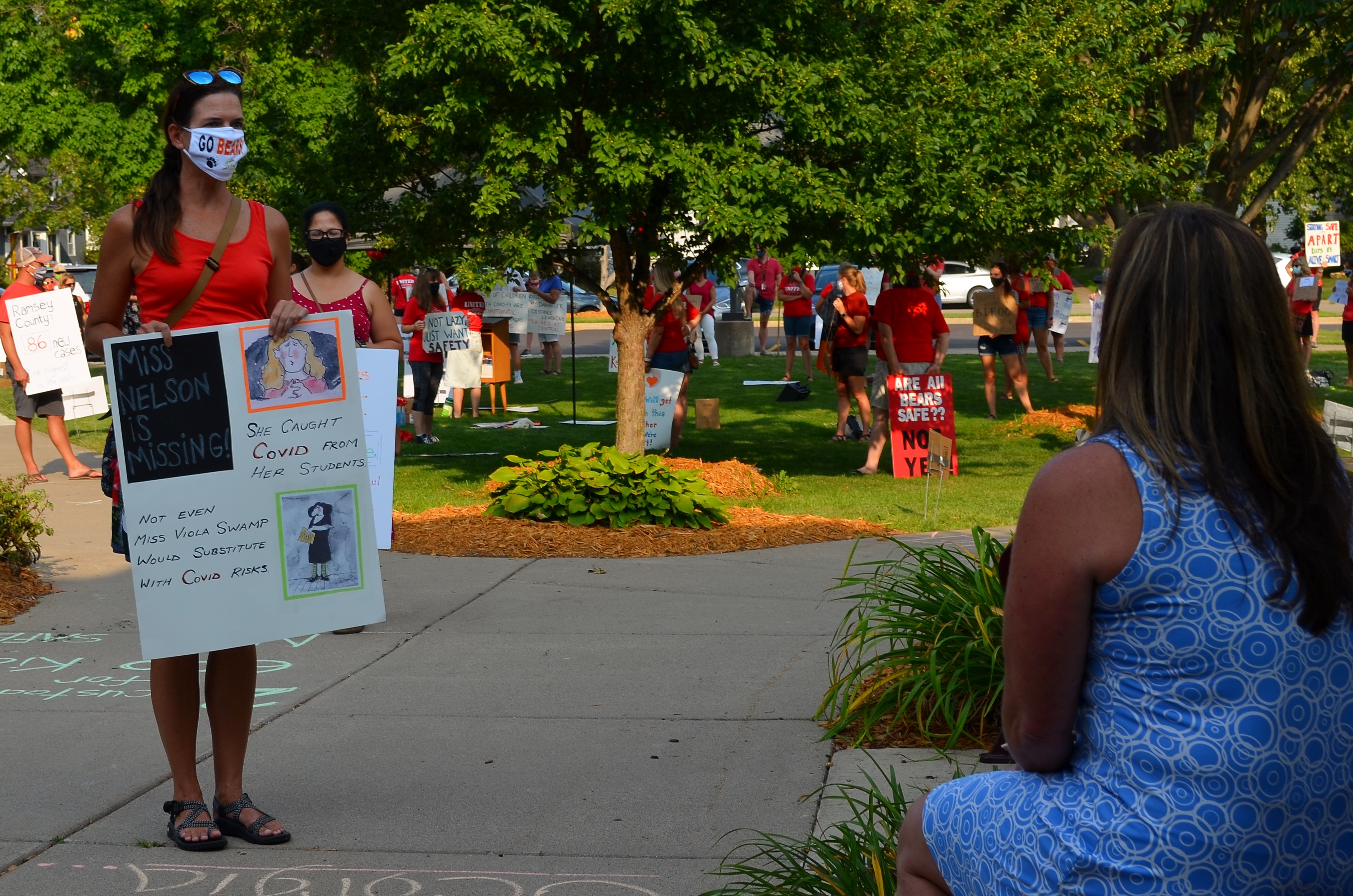
Members of the White Bear Lake Area Educators rally before a school board meeting, urging the district to delay its plan to return to in-person classes.

Share
As school districts across Minnesota prepare for a school year unlike any other, the union members who work in public education are pushing for a voice in decisions impacting their health – and the health of their communities.
State guidelines announced by Gov. Tim Walz in July set the ground rules for reopening public school buildings during the COVID-19 pandemic, but allow districts leeway to craft their own protocols.
What should not be optional, unions say, is collaboration and communication with their employees. But in several districts across the metro, union members are calling out administrators for looking past workers’ concerns as they push forward with plans to reopen.
“The communication that is received by staff and families is vague at best and non-existent at worst,” said Karin Hogan, an educator in the White Bear Lake Area Schools, where union members rallied before the school board tonight.
“Educators are feeling extremely wary, scared and nervous about going back to school because of all of our unanswered questions surrounding safety, consistency, and educational quality,” Hogan said.
Until they get specific answers to those questions, union members want administrators to pump the brakes on in-person learning, set to begin Sept. 8 with a hybrid approach that combines in-person and at-home learning. In a survey of union members, 74% said they prefer distance learning to start the year.
“Our union is appreciative of the cooperation that the administration is currently showing with our negotiations committee. It is more than many other districts,” Hogan said. “However, it is not enough to address and alay our concerns.”
Unions representing school employees initially praised the governor’s reopening guidelines as data-driven and based in science.
But Denise Specht, president of Education Minnesota, stressed that readying school buildings would take a “tremendous amount of work,” and she cautioned local districts against settling for “safe enough” to meet arbitrary deadlines for starting classes.
“We know we have a lot of work to do before school can start this fall,” Kelly Gibbons, president of SEIU Local 284, added. “We are committed to doing everything in our power to make sure every district in the state, no matter what their plan may be, is putting the health and safety of students, staff and our communities before everything else.”
Already, local unions are reporting problems.

Under Walz’s executive order, districts are required to accommodate staff members with health conditions that put them at elevated risk to COVID-19.
But Specht has said she is “deeply troubled” that educators’ requests for accommodation haven’t always been taken seriously. In a public statement, she listed several examples of complaints – some “plainly illegal” – Education Minnesota has heard from its members.
“We can and must do better,” Specht said. “Education Minnesota calls on school districts in this state to be model employers.”
The American Federation of Teachers has authorized educators to go on “safety strikes” during the pandemic as a last resort in efforts to secure certain protections on the job. But some metro districts are doing better by their employees without large-scale worker mobilizations.
In St. Paul, where the coronavirus cut short a contentious educator strike in March, administrators not only invited members of the St. Paul Federation of Educators to join work groups charged with planning for the fall semester, but took their input seriously, SPFE President Nick Faber said.
“Most of the discussion was around hybrid and returning to classrooms, what it would look like to go back,” Faber said. “It seemed like every time we answered a question or concern, it just opened up 50 more. It was just not logistically possible to do it safely.”
The St. Paul Public Schools will begin the school year with remote learning for all students, a move Faber characterized as the least-bad option on the table for SPFE members.
“Our members aren’t crazy about having to go back to teaching over a computer screen, often while their own kids are in the house somewhere,” he said. “But they know this is the safest way.”
Other metro-area school districts, including Roseville and Bloomington, have recently come to similar conclusions, postponing their initial plans for in-person classes due to safety concerns.
Tiffany Dittrich, president of the White Bear Lake educators union, hopes her district will do the same. Two weeks ago, she presented administrators with a list of over 100 questions about the safety and quality of instruction under the district’s back-to-school plan. Most remain unanswered, Dittrich said.
“I’m proud of the tireless work of our district leaders and teacher leaders throughout the entire summer to set the stage for our return this fall,” she said. “Yet there is much work that must still be done … and time is running far too short.”

